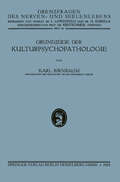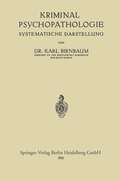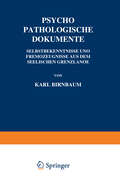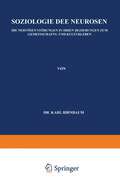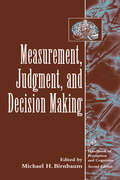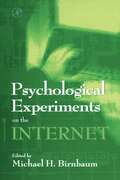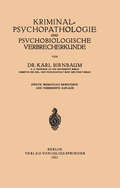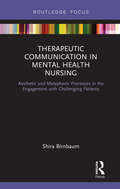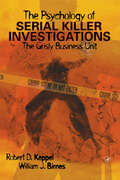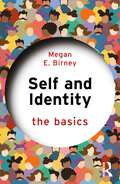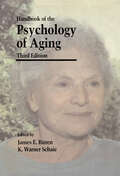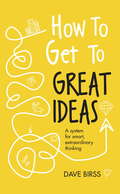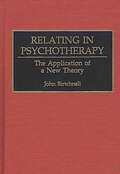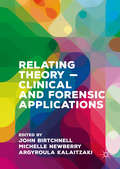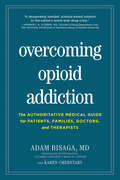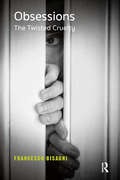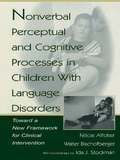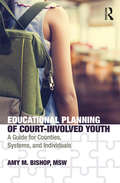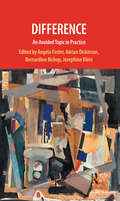- Table View
- List View
Grundzüge der Kulturpsychopathologie
by Karl BirnbaumDieser Buchtitel ist Teil des Digitalisierungsprojekts Springer Book Archives mit Publikationen, die seit den Anfängen des Verlags von 1842 erschienen sind. Der Verlag stellt mit diesem Archiv Quellen für die historische wie auch die disziplingeschichtliche Forschung zur Verfügung, die jeweils im historischen Kontext betrachtet werden müssen. Dieser Titel erschien in der Zeit vor 1945 und wird daher in seiner zeittypischen politisch-ideologischen Ausrichtung vom Verlag nicht beworben.
Kriminal-Psychopathologie: Systematische Darstellung
by Karl BirnbaumDieser Buchtitel ist Teil des Digitalisierungsprojekts Springer Book Archives mit Publikationen, die seit den Anfängen des Verlags von 1842 erschienen sind. Der Verlag stellt mit diesem Archiv Quellen für die historische wie auch die disziplingeschichtliche Forschung zur Verfügung, die jeweils im historischen Kontext betrachtet werden müssen. Dieser Titel erschien in der Zeit vor 1945 und wird daher in seiner zeittypischen politisch-ideologischen Ausrichtung vom Verlag nicht beworben.
Psychopathologische Dokumente: Selbstbekenntnisse und Fremdƶeugnisse aus dem Seelischen Grenƶlande
by Karl BirnbaumDieser Buchtitel ist Teil des Digitalisierungsprojekts Springer Book Archives mit Publikationen, die seit den Anfängen des Verlags von 1842 erschienen sind. Der Verlag stellt mit diesem Archiv Quellen für die historische wie auch die disziplingeschichtliche Forschung zur Verfügung, die jeweils im historischen Kontext betrachtet werden müssen. Dieser Titel erschien in der Zeit vor 1945 und wird daher in seiner zeittypischen politisch-ideologischen Ausrichtung vom Verlag nicht beworben.
Soziologie der Neurosen: Die Nervösen Störungen in Ihren Beziehungen zum Gemeinschafts- und Kulturleben
by Karl BirnbaumDieser Buchtitel ist Teil des Digitalisierungsprojekts Springer Book Archives mit Publikationen, die seit den Anfängen des Verlags von 1842 erschienen sind. Der Verlag stellt mit diesem Archiv Quellen für die historische wie auch die disziplingeschichtliche Forschung zur Verfügung, die jeweils im historischen Kontext betrachtet werden müssen. Dieser Titel erschien in der Zeit vor 1945 und wird daher in seiner zeittypischen politisch-ideologischen Ausrichtung vom Verlag nicht beworben.
Measurement, Judgment, and Decision Making (Handbook of Perception and Cognition, Second Edition)
by Michael H. BirnbaumMeasurement, Judgment, and Decision Making provides an excellent introduction to measurement, which is one of the most basic issues of the science of psychology and the key to science. Written by leading researchers, the book covers measurement, psychophysical scaling, multidimensional scaling, stimulus categorization, and behavioral decision making. Each chapter provides a useful handbook summary and unlocks the door for a scholar who desires entry to that field. Any psychologist who manipulates an independent variable that affects a psychological construct or who uses a numerical dependent variable to measure a psychological construct will want to study this book.Written by leading researchers in fields of measurement, psychophysical scaling, multidimensional scaling, stimulus categorization, and behavioral decision makingProvides basic definitions and summaries of theoriesPresents summaries and citations to relevant literatureContains new developments, current controversies, and open questionsExplains relationships among fields and historical links
Psychological Experiments on the Internet
by Michael H. BirnbaumUntil recently, most psychological research was conducted using subject samples in close proximity to the investigators--namely university undergraduates. In recent years, however, it has become possible to test people from all over the world by placing experiments on the internet. The number of people using the internet for this purpose is likely to become the main venue for subject pools in coming years. As such, learning about experiments on the internet will be of vital interest to all research psychologists. Psychological Experiments on the Internet is divided into three sections. Section I discusses the history of web experimentation, as well as the advantages, disadvantages, and validity of web-based psychological research. Section II discusses examples of web-based experiments on individual differences and cross-cultural studies. Section III provides readers with the necessary information and techniques for utilizing the internet in their own research designs.Innovative topic that will capture the imagination of many readersIncludes examples of actual web based experiments
Kriminal≈Psychopathologie und Psychobiologische Verbrecherkunde
by NA BirnbaumDieser Buchtitel ist Teil des Digitalisierungsprojekts Springer Book Archives mit Publikationen, die seit den Anfängen des Verlags von 1842 erschienen sind. Der Verlag stellt mit diesem Archiv Quellen für die historische wie auch die disziplingeschichtliche Forschung zur Verfügung, die jeweils im historischen Kontext betrachtet werden müssen. Dieser Titel erschien in der Zeit vor 1945 und wird daher in seiner zeittypischen politisch-ideologischen Ausrichtung vom Verlag nicht beworben.
Therapeutic Communication in Mental Health Nursing: Aesthetic and Metaphoric Processes in the Engagement with Challenging Patients
by Shira BirnbaumAwarded first place in the 2017 AJN Book of the Year Awards in Psychiatric and Mental Health Nursing. This book introduces an innovative technique for therapeutic communication in mental health nursing, expanding the toolkit for nurses seeking to engage challenging patients who have not responded to more conventional therapeutic methods. Linking nursing communication to current research on metaphor and figuration, it is illustrated with accessible clinical examples. Metaphor is a key component of talk-based psychotherapies. But many of the patients whom nurses encounter in the inpatient setting are not good candidates for talk-based approaches, at least initially, because they are violent, withdrawn, highly regressed, or otherwise lacking a vocabulary to convey thoughts and feelings. This book offers specific clinical examples of an approach called the "gestural bridge." This is a method for structuring games and physical activities which connect metaphorically to a patient’s personal themes, activating narrative and observational agency and enabling an exchange of meaning to begin at a time when conventional language is not available. Rooted in what nursing theorists have called the "embodied" or "aesthetic" way of knowing, this approach is both specific and easily grasped. Drawing from contemporary work in literary theory, semiotics, metaphor theory, cognitive science, philosophy, linguistics, psychoanalysis, and the arts, Therapeutic Communication in Mental Health Nursing is important reading for advanced-level practitioners, students, and researchers interested in communication and relationship-building in nursing.
Therapeutic Communication in Mental Health Nursing: Aesthetic and Metaphoric Processes in the Engagement with Challenging Patients
by Shira BirnbaumAwarded first place in the 2017 AJN Book of the Year Awards in Psychiatric and Mental Health Nursing. This book introduces an innovative technique for therapeutic communication in mental health nursing, expanding the toolkit for nurses seeking to engage challenging patients who have not responded to more conventional therapeutic methods. Linking nursing communication to current research on metaphor and figuration, it is illustrated with accessible clinical examples. Metaphor is a key component of talk-based psychotherapies. But many of the patients whom nurses encounter in the inpatient setting are not good candidates for talk-based approaches, at least initially, because they are violent, withdrawn, highly regressed, or otherwise lacking a vocabulary to convey thoughts and feelings. This book offers specific clinical examples of an approach called the "gestural bridge." This is a method for structuring games and physical activities which connect metaphorically to a patient’s personal themes, activating narrative and observational agency and enabling an exchange of meaning to begin at a time when conventional language is not available. Rooted in what nursing theorists have called the "embodied" or "aesthetic" way of knowing, this approach is both specific and easily grasped. Drawing from contemporary work in literary theory, semiotics, metaphor theory, cognitive science, philosophy, linguistics, psychoanalysis, and the arts, Therapeutic Communication in Mental Health Nursing is important reading for advanced-level practitioners, students, and researchers interested in communication and relationship-building in nursing.
The Psychology of Serial Killer Investigations: The Grisly Business Unit
by William J. Birnes Robert D. KeppelSerial killers like Seattle's Ted Bundy, Maryland's Beltway Sniper, Atlanta's Wayne Williams, or England's Peter Sutcliffe usually outsmart the task forces on their trail for long periods of time. Keppel and Birnes take readers inside the operations of serial killer task forces to learn why. What is the underlying psychology of a serial killer and why this defeats task force investigations? This is the first book of its kind that combines state-of-the-art psychological assessment experience with the expertise of a homicide investigator who has tracked some of this country's most notorious serial killers. The author also brings to the book hands-on best practices gleaned from the experience of other task forces. Readers, both professionals and students, will benefit from the comprehensive and critical case reviews, the analysis of what went wrong, what went right, and the after-action recommendations of evaluators in the US, UK, and Canada. The book covers: * The nature of the psychology of a serial killer * How crime assessment profiling reveals that psychology * Why psychological profiles fail * How serial killer task forces defeat themselves * How the media can, and usually does, undermine the task force operation * The big secret of all serial killer investigations: police already have the killer's name * The best practices for catching a serial killer* Comprehensive case reviews of some of the US's and UK's most baffling serial killer cases * A list of best practices for serial killer task force investigators * Recommendations for how to manage comprehensive files and computer records* Practical advice on how to manage the media: what to say and not to say* Insight into what a serial killer might be thinking and doing to stay away from police* Recommendations for setting up and administering long-term investigations* Practical tips on how to maintain a task force's psychological edge and avoid defeatism
Self and Identity: The Basics (The Basics)
by Megan E. BirneySelf and Identity: The Basics is a jargon-free and accessible introduction that draws on key theories and ideas in Social Psychology to explore the ways that other people affect our thoughts, feelings, and behaviours. Highlighting selfhood as a function of identity, the book shows that it is our relationships with others in our social world that largely determine who we are. "Who am I?" It’s a question that most all humans have grappled with at some point or another. This book seeks to answer this question through relatable examples that show how psychological theory can be applied to our own lives. It considers the philosophical and psychological context in which ideas about selfhood have developed and reviews the ways that the people around us, and the groups that we belong to, affect who we are. Finally, these ideas are considered in the context of real-world phenomena and behaviours; for instance, how we use language, conflict between groups, and social influence. With a glossary of key terms, suggestions for further reading, and chapter summaries, this book is an ideal introduction for students of social psychology and related fields. It will be of interest to anyone who wants to gain social psychological insight into who they are and how others got them there.
Self and Identity: The Basics (The Basics)
by Megan E. BirneySelf and Identity: The Basics is a jargon-free and accessible introduction that draws on key theories and ideas in Social Psychology to explore the ways that other people affect our thoughts, feelings, and behaviours. Highlighting selfhood as a function of identity, the book shows that it is our relationships with others in our social world that largely determine who we are. "Who am I?" It’s a question that most all humans have grappled with at some point or another. This book seeks to answer this question through relatable examples that show how psychological theory can be applied to our own lives. It considers the philosophical and psychological context in which ideas about selfhood have developed and reviews the ways that the people around us, and the groups that we belong to, affect who we are. Finally, these ideas are considered in the context of real-world phenomena and behaviours; for instance, how we use language, conflict between groups, and social influence. With a glossary of key terms, suggestions for further reading, and chapter summaries, this book is an ideal introduction for students of social psychology and related fields. It will be of interest to anyone who wants to gain social psychological insight into who they are and how others got them there.
Handbook of the Psychology of Aging
by James E. BirrenHandbook of the Psychology of Aging, Third Edition describes the psychology of adult development and aging. This book is organized into four parts encompassing 28 chapters that cover the basic behavioral changes and capacities occurring with advancing age. The first part deals with the history, concept, and models of the psychology of aging. This part also examines the distinctions between physical, biological, psychological, and social time or age. The second part explores the influences of racial, ethnic, and cultural factors on biological/health, social, and psychological aging processes. This part also surveys gender differences in aging. The third part describes numerous behavioral processes, changes, and patterns in advancing age. This part specifically considers the motivation, cognitive and motor performance, attentional processes, learning, memory, personality, and wisdom in aging. The fourth part focuses on the applications of the concepts and principles of aging to the individual and society. This book will be of great value to psychologists, researchers, and graduate students.
How to Get to Great Ideas: A system for smart, extraordinary thinking
by Dave BirssThe highly practical lessons in How to Get to Great Ideas are based on neuroscience, psychology and sociology. Written by former advertising creative director Dave Birss, this book offers a brilliant new system for conceiving original and valuable ideas. It looks at how to frame a problem, how to push your thinking, how to sell the idea, how to build support for it and how to inspire others to have great ideas. It proves that any organization - and any individual or department within an organization - can create a fertile environment for ideas. Combining a practical research-based system with fascinating insights and inspiring and humorous writing, the book also includes the problem-solving system RIGHT Thinking. This is a tool which enables a more effective way to generate more effective ideas, and is one that anyone can use to transform themselves or their business. Training on this system is also available in person from the author. And will be released soon as an online course.
Relating in Psychotherapy: The Application of a New Theory (Human Evolution, Behavior, and Intelligence)
by John BirtchnellIn his earlier book, How Humans Relate, John Birtchnell proposed that relating occurs along two axes, a horizontal one concerning becoming close versus being distant and a vertical one concerning being upper versus being lower. He called closeness, distance, upperness, and lowerness the relating objectives, and he proposed that people need to acquire competence in attaining and maintaining these objectives. In this book, he argues that the task of psychotherapists is to identify and correct, within these axes, people's relating incompetencies, and to enable people to cope with the relating incompetencies of others. He considers this to be the case across all psychotherapies.Dr. Birtchnell proposes the existence of an unconscious, automatic, inner brain that monitors the relating objectives. He argues that the psychotherapist assists the person, through the conscious, outer brain, to correct and improve the inner brain's least effective relating strategies. He uses the term interrelating to describe the interplay between the relating of two or more people. This has application in couple, family, group, and community therapy, in which the psychotherapist's task is to enable the interrelaters to understand and correct their mutually reinforcing, destructive interactions. He introduces a set of questionnaires, from the scores of which a computer can print out an easy-to-read diagram of the direction and degree of people's relating incompetencies.
Relating Theory – Clinical and Forensic Applications
by John Birtchnell Michelle Newberry Argyroula KalaitzakiThis book brings together recent research developments in relating theory. It is divided into four parts, which introduce the reader to relating theory, how it has developed and how it can be applied to clinical and forensic psychology. Topics include how couples relate to one another, how young people relate to their parents, how assessments of relating can be used in therapy, how specific negative relating styles relate to offending behaviour, risk taking and alcohol use, psychopathic and sadistic tendencies, and how the interpersonal relating of offenders can change during treatment in prison. The book covers international research involving both quantitative and qualitative methods, and will be of interest to clinicians, academics and both undergraduate and postgraduate students in the fields of psychology, clinical psychology, forensic/criminal psychology, psychiatry, psychotherapy, counselling, art-therapy, and mental health.
Overcoming Opioid Addiction: The Authoritative Medical Guide for Patients, Families, Doctors, and Therapists
by Adam Bisaga MD Karen ChernyaevFrom a leading addiction expert, a desperately needed medical guide to understanding, treating, and finally defeating opioid use disorder Drug overdoses are now the leading cause of death for Americans under the age of 50, claiming more lives than the AIDs epidemic did at its peak. Opioid abuse accounts for two-thirds of these overdoses, with over 100 Americans dying from opioid overdoses every day. Now Overcoming Opioid Addiction provides a comprehensive medical guide for opioid use disorder (OUD) sufferers, their loved ones, clinicians, and other professionals. Here is expertly presented, urgently needed information and guidance, including: Why treating OUD is unlike treating any other form of drug dependencyThe science that underlies addiction to opioids, and a clear analysis of why this epidemic has become so deadlyThe different stages and effective methods of treatment, including detoxification vs. maintenance medications, as well as behavioral therapiesHow to deal with relapses and how to thrive despite OUDPlus a chapter tailored to families with crucial, potentially life-saving information, such as how to select the best treatment program, manage medications, and reverse an overdose.
Obsessions: The Twisted Cruelty
by Francesco BisagniThis book explores the interrelatedness between obsessive compulsive disorders, thinking disorders, and depression. The issue is considered both from a psychiatric viewpoint and from a psychodynamic perspective. The age of the cases presented in the book ranges from childhood through adolescence to adulthood. Obsessions: The Twisted Cruelty is a challenging contribution to contemporary clinical debate, especially regarding the role of analytically-oriented psychotherapy in the treatment of OCD, and how to deal with the psychiatric treatment and combine the two approaches, while keeping the focus on the transference-countertransference interplay. After the first theoretical chapter, the relationship between obsessions and thinking impairments is discussed, with specific reference to delusional ideation. A section entitled "the anal conundrum" follows. Encopresis and anal masturbation during childhood are discussed, as well as the identification of the child with a maternal "faecal object. The last section explores the connection with depression, and some specific features of sadism.
Obsessions: The Twisted Cruelty
by Francesco BisagniThis book explores the interrelatedness between obsessive compulsive disorders, thinking disorders, and depression. The issue is considered both from a psychiatric viewpoint and from a psychodynamic perspective. The age of the cases presented in the book ranges from childhood through adolescence to adulthood. Obsessions: The Twisted Cruelty is a challenging contribution to contemporary clinical debate, especially regarding the role of analytically-oriented psychotherapy in the treatment of OCD, and how to deal with the psychiatric treatment and combine the two approaches, while keeping the focus on the transference-countertransference interplay. After the first theoretical chapter, the relationship between obsessions and thinking impairments is discussed, with specific reference to delusional ideation. A section entitled "the anal conundrum" follows. Encopresis and anal masturbation during childhood are discussed, as well as the identification of the child with a maternal "faecal object. The last section explores the connection with depression, and some specific features of sadism.
Nonverbal Perceptual and Cognitive Processes in Children With Language Disorders: Toward A New Framework for Clinical intervention
by Walter Bischofberger F‚licie AffolterA growing body of literature is suggesting that many children with language disorders and delays--even those with so-called specific language impairment--have difficulties in other domains as well. In this pathbreaking book, the authors draw on more than 40 years of research and clinical observations of populations ranging from various groups of children to adults with brain damage to construct a comprehensive model for the development of the interrelated skills involved in language performance, and trace the crucial implications of this model for intervention. Early tactual feedback, they argue, is more critical for the perceptual/cognitive organization of experiences that constitutes a foundation for language development than either visual or auditory input, and the importance of tactually-anchored nonverbal interaction cannot be ignored if efforts at treatment are to be successful. All those professionally involved in work with children and adults with language problems will find the authors' model provocative and useful.
Nonverbal Perceptual and Cognitive Processes in Children With Language Disorders: Toward A New Framework for Clinical intervention
by Walter Bischofberger F‚licie AffolterA growing body of literature is suggesting that many children with language disorders and delays--even those with so-called specific language impairment--have difficulties in other domains as well. In this pathbreaking book, the authors draw on more than 40 years of research and clinical observations of populations ranging from various groups of children to adults with brain damage to construct a comprehensive model for the development of the interrelated skills involved in language performance, and trace the crucial implications of this model for intervention. Early tactual feedback, they argue, is more critical for the perceptual/cognitive organization of experiences that constitutes a foundation for language development than either visual or auditory input, and the importance of tactually-anchored nonverbal interaction cannot be ignored if efforts at treatment are to be successful. All those professionally involved in work with children and adults with language problems will find the authors' model provocative and useful.
Educational Planning of Court-Involved Youth: A Guide for Counties, Systems, and Individuals
by Amy BishopEducational Planning of Court-Involved Youth provides a framework for alleviating chronic barriers for youth in the child welfare and juvenile justice systems. This guide combines best-practice recommendations from national research with direct service tactics employed successfully in multiple counties. Included are the necessary components to implement a collaborative, community-centered intervention system that meets the needs of the county, family, and individual. With the understanding that each county carries its own strengths, barriers, and resources, these tools serve as a model for assessing and adapting the system to cater to the unique needs of each area in which it is implemented. This text helps facilitate the coordination and collaboration necessary to foster comprehensive systems and individualized planning for youth.
Educational Planning of Court-Involved Youth: A Guide for Counties, Systems, and Individuals
by Amy BishopEducational Planning of Court-Involved Youth provides a framework for alleviating chronic barriers for youth in the child welfare and juvenile justice systems. This guide combines best-practice recommendations from national research with direct service tactics employed successfully in multiple counties. Included are the necessary components to implement a collaborative, community-centered intervention system that meets the needs of the county, family, and individual. With the understanding that each county carries its own strengths, barriers, and resources, these tools serve as a model for assessing and adapting the system to cater to the unique needs of each area in which it is implemented. This text helps facilitate the coordination and collaboration necessary to foster comprehensive systems and individualized planning for youth.
Difference: An Avoided Topic in Practice
by Bernardine BishopDifference is a complex and often disturbing issue. The purpose of this book is to encourage a culture of open enquiry into an emotionally charged subject which, the editors argue, has been largely avoided by the profession. Theoretically psychoanalysis is all about recognition and appreciation of difference, yet the psychoanalytic profession itself does not have a good reputation in this area. This is a courageous collection of papers. All contributors have been prepared to go into print about situations in which difference is a significant element in their work and one around which they have felt uneasy and uncertain as they have found themselves in uncharted territory. Through painstaking analysis of their experience and that of their patients and clients, each contributor provides the reader with some useful insights and guidelines for future reference as well as some clear and stimulating illustrations of effective thinking in strange and disturbing situations. What makes this thinking effective is the demonstrated ability of all contributors to preserve their analytic functioning whatever the circumstances.
Difference: An Avoided Topic in Practice (The\lcp Practice In Psychotherapy Ser.)
by Bernardine BishopDifference is a complex and often disturbing issue. The purpose of this book is to encourage a culture of open enquiry into an emotionally charged subject which, the editors argue, has been largely avoided by the profession. Theoretically psychoanalysis is all about recognition and appreciation of difference, yet the psychoanalytic profession itself does not have a good reputation in this area. This is a courageous collection of papers. All contributors have been prepared to go into print about situations in which difference is a significant element in their work and one around which they have felt uneasy and uncertain as they have found themselves in uncharted territory. Through painstaking analysis of their experience and that of their patients and clients, each contributor provides the reader with some useful insights and guidelines for future reference as well as some clear and stimulating illustrations of effective thinking in strange and disturbing situations. What makes this thinking effective is the demonstrated ability of all contributors to preserve their analytic functioning whatever the circumstances.
